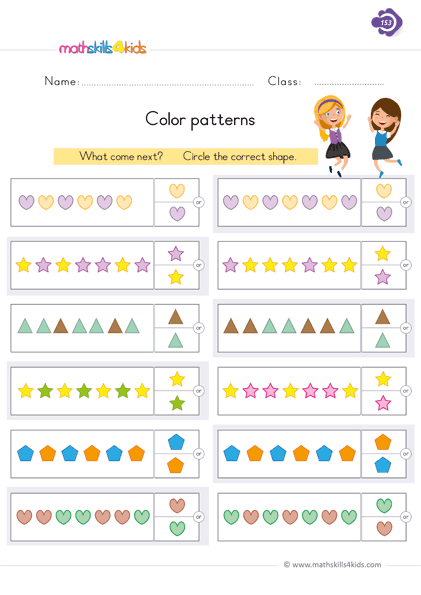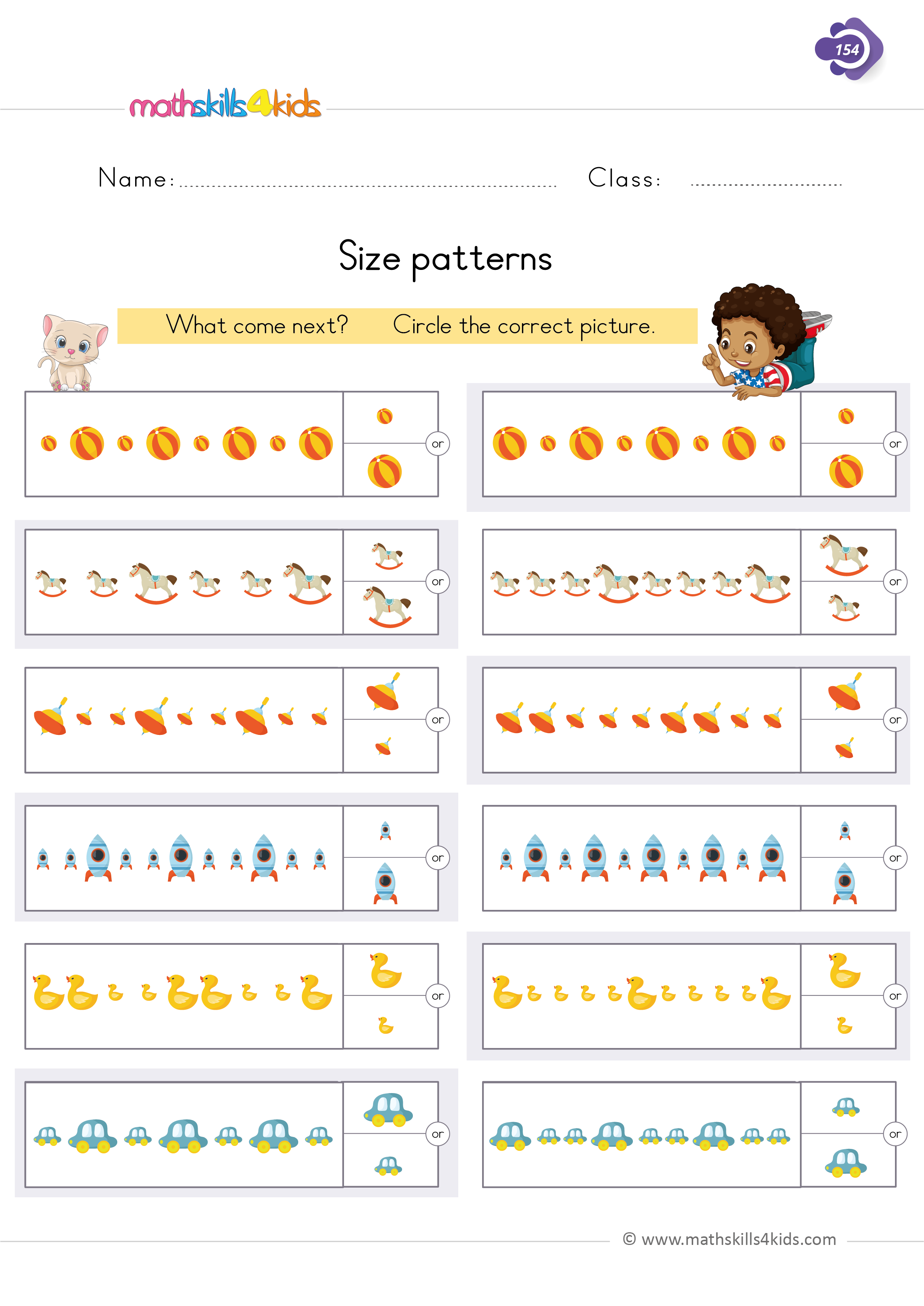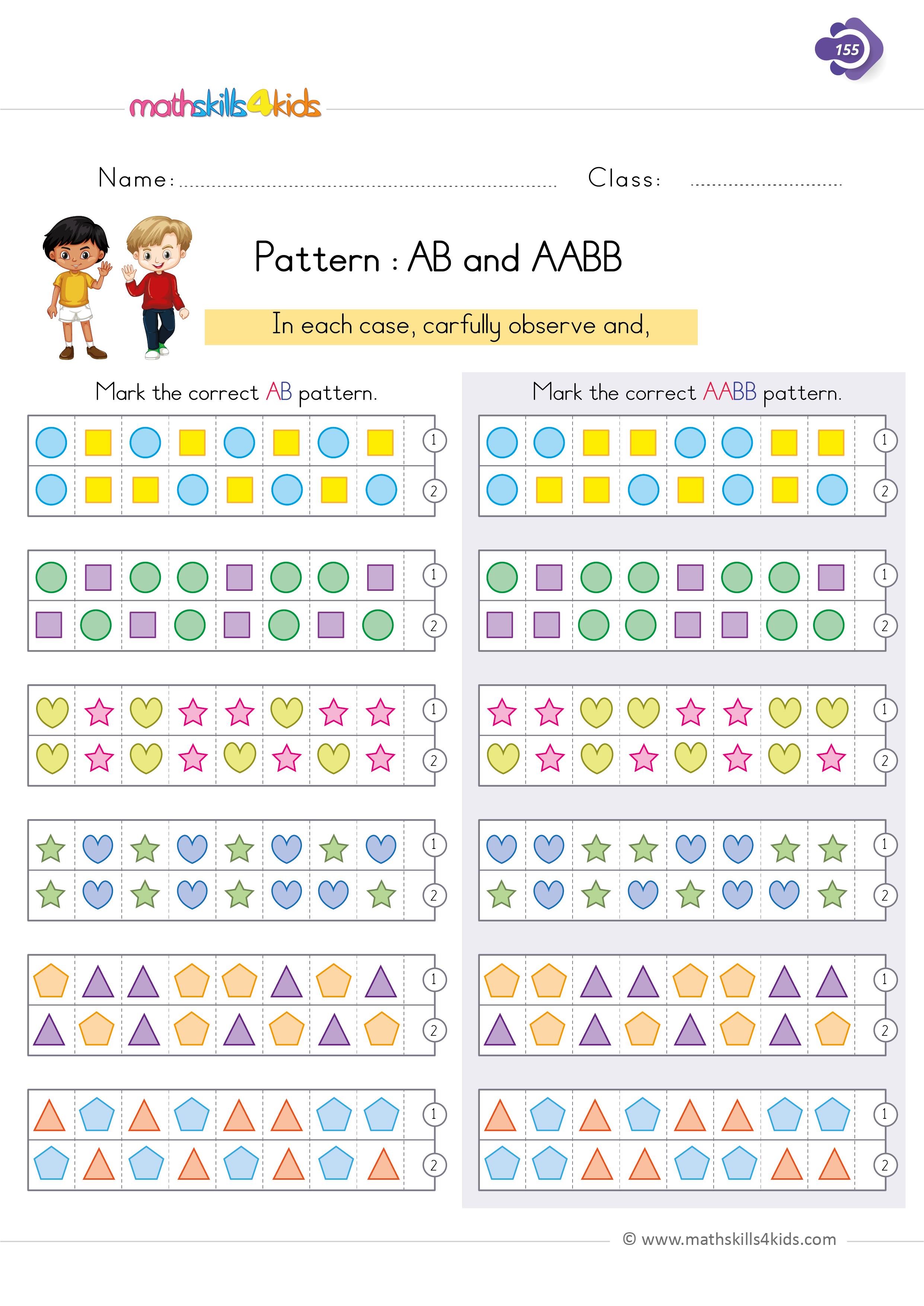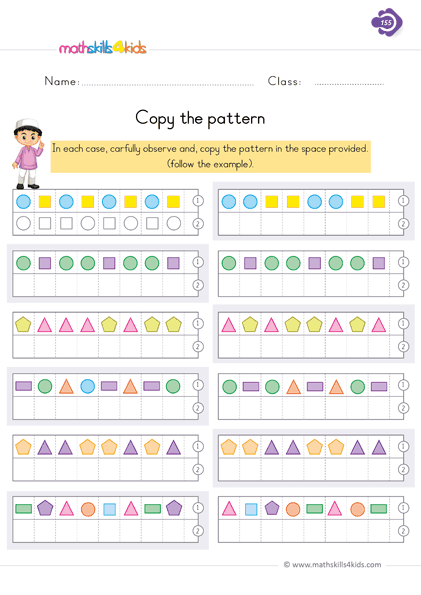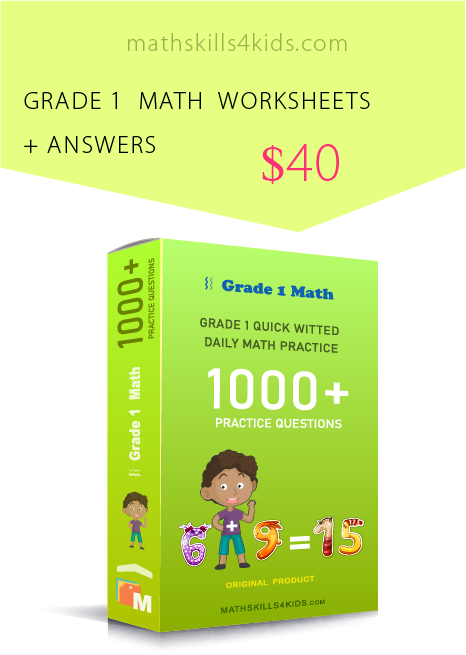1st Grade free printable pattern worksheets: Fun & engaging activities
Are you looking for fun and engaging activities to help your 1st grader develop their pattern recognition skills? If so, you've come to the right place! In this premium resource, we'll share with you why pattern recognition is essential for 1st graders, what patterns are and how to identify them, types of patterns, 1st Grade free printable pattern worksheets, and some fun and engaging activities to reinforce your 1st grader's pattern skills.
Let's get started!
-
Why pattern recognition is important for 1st graders
Below are some amazing points on the importance of pattern recognition to 1st graders.
Pattern recognition is noticing and understanding the regularities and rules in a set of objects, shapes, numbers, sounds, or actions. It is a foundational skill for math and science learning, as well as for everyday problem-solving and creativity.
Pattern recognition helps 1st graders to:
- Develop their logical thinking and reasoning skills
- Enhance their visual-spatial awareness and attention to detail
- Recognize and extend sequences and series
- Understand the concept of variables and functions
- Explore algebraic thinking and relationships
- Make predictions and generalizations based on patterns
-
BROWSE THE WEBSITE
-
DOWNLOAD FREE WORKSHEETS
-
-
1st GRADE MATH TOPICS
- Counting and numbers
- Understand addition
- Addition skills
- Addition exercises
- Addition strategies
- Understand subtraction
- Subtraction skills
- Subtraction Exercises
- Subtraction strategies
- Mixed operation
- Comparing numbers up to 100
- Estimation Worksheets
- Place value
- Spatial sense
- Graphing & data
- Measurement
- Patterns
- Probability
- Sorting & classifying
- Telling time
- 2D shapes
- 3D shapes - Solids figures
- Fractions
-
-
What are patterns, and how to identify them
A pattern is a set of elements that follows a rule or logic. The elements can be anything, such as shapes, colors, sizes, numbers, letters, sounds, or actions. To identify a pattern, you need to look for the following features:
- The core is the smallest part of the pattern that repeats itself. For example, in the pattern ABABAB, the core is AB.
- The term is one element of the pattern. For example, in the pattern, ABABAB, each A and B is a term.
- The length is the number of terms in the core. For example, in the pattern ABABAB, the length is 2.
- The order is the way the terms are arranged in the core. For example, in the pattern ABABAB, the order is A, followed by B.
To identify a pattern, you need to look for the core, the term, the length, and the order of the elements. Then you can describe the pattern using words or symbols.
-
Types of patterns: Repeating, Growing, and Shrinking
There are three main types of patterns that 1st graders need to learn: repeating patterns, growing patterns, and shrinking patterns.
- Repeating patterns: A repeating pattern is a pattern that has a core that repeats itself over and over again. For example, ABABAB is a repeating pattern with a core of AB.
Repeating patterns can have different lengths and orders. For example, ABCABC is a repeating pattern with a length of 3 and an order of ABC.
- Growing patterns: A growing pattern is a pattern that has a core that increases in size or quantity with each repetition. For example, ABBCCCDDD is a growing pattern with a core of ABBCCCDDD.
Growing patterns can have different rules or logic for how they grow. For example, ABAABAAABA is a growing pattern that adds one more A with each repetition.
- Shrinking patterns: A shrinking pattern is a pattern that has a core that decreases in size or quantity with each repetition. For example, ABCDEDCBA is a shrinking pattern with a core of ABCDEDCBA.
Shrinking patterns can have different rules or logic for how they shrink. For example, ABCDEEDCBA is a shrinking pattern that removes one letter from the middle with each repetition.
- Repeating patterns: A repeating pattern is a pattern that has a core that repeats itself over and over again. For example, ABABAB is a repeating pattern with a core of AB.
-
Free printable pattern worksheets: How to use them effectively
To help your 1st grader practice their pattern recognition skills, we've created free printable pattern worksheets you can download and print at home. All these worksheets are available in Mathskills4kids, covering different types of patterns and different difficulty levels. Here's how to use them effectively:
Color Pattern: What Comes Next?
This worksheet has color patterns your child needs to complete by coloring the next term. The patterns are repeating patterns with different lengths and orders. This worksheet helps your child to:
- Recognize and extend color patterns
- Identify the core, the term, the length, and the order of color patterns
- Use visual cues to find the logic of color patterns
Size Pattern: What Comes Next?
This worksheet has size patterns your child needs to complete by drawing or circling the next term. The patterns are repeating patterns with different lengths and orders. The terms are shapes that vary in size from small to large or vice versa. This worksheet helps your child to:
- Recognize and extend size patterns
- Identify the core, the term, the length, and the order of size patterns
- Use spatial cues to find the logic of size patterns
Copy the Pattern
This worksheet has patterns your child needs to copy by drawing or coloring the same terms. These copy patterns are repeating, growing, and shrinking patterns with different cores and rules. The terms are shapes, numbers, or letters. This worksheet helps your child to:
- Recognize and copy different types of patterns
- Identify the core and the rule of different types of patterns
- Use symbolic cues to find the logic of different types of patterns
AB and AABB Patterns
This worksheet has patterns your child needs to complete by writing the next term. The patterns are repeating patterns with a length of 2 or 4. The terms are letters from A to Z. This worksheet helps your child to:
- Recognize and extend AB and AABB patterns
- Identify the core, the term, the length, and the order of AB and AABB patterns
- Use alphabetical cues to find the logic of AB and AABB patterns
-
Fun and engaging activities to reinforce pattern skills
Besides using the free printable pattern worksheets, you can also try fun and engaging activities to reinforce your child's pattern skills.
Here are some ideas:
- Make a pattern with objects: You can use any objects you have at home, such as Lego bricks, buttons, beads, coins, stickers, etc.
Arrange them in a pattern and ask your child to identify the core, the term, the length, and the order of the pattern. Then ask your child to extend the pattern by adding more objects.
You can also ask your child to make their own pattern with objects and explain it to you.
- Make a pattern with sounds: You can use any sounds you can make with your voice or body, such as clapping, snapping, tapping, humming, etc.
Make a sound pattern and ask your child to listen and repeat it. Then ask your child to complete the pattern by making the next sound.
You can also ask your child to make and explain their own sound pattern.
- Make a pattern with actions: You can use any actions you can do with your body, such as jumping, hopping, skipping, spinning, etc.
Do an action pattern and ask your child to watch and copy it. Then ask your child to complete the pattern by doing the next action.
You can also ask your child to make and explain their own action pattern.
- Make a pattern with objects: You can use any objects you have at home, such as Lego bricks, buttons, beads, coins, stickers, etc.
How to assess your child's progress and provide feedback
To assess your child's progress and provide feedback on their pattern recognition skills, you can use the following tips:
- Observe how your child solves the worksheets or activities: Pay attention to how your child approaches the patterns, how they identify the features and logic of the patterns, how they extend or copy the patterns, and how they explain their reasoning.
- Ask open-ended questions: Ask questions that encourage your child to think deeper and explain their thinking process. For example;
"How did you find the core of this pattern?", "What is the rule for this growing pattern?", "How can you check if your answer is correct?" etc.
- Praise their efforts and achievements: Praise your child for their efforts and achievements in solving the worksheets or activities. For example;
"You did a great job completing this color pattern!", "You found the core of this size pattern very quickly!", "You made a very creative sound pattern!" etc.
- Provide constructive feedback: Provide feedback that helps your child improve their skills and learn from their mistakes. For example;
"This is a good start, but you missed one term in this shrinking pattern.", "This is not quite right because this is not a repeating pattern.", "You need to pay more attention to the order of this AB pattern.", etc.
Thank you for sharing the links of MathSkills4Kids.com with your loved ones. Your choice is greatly appreciated.
We hope you found this article helpful and informative. Pattern recognition is a very important skill for 1st graders that will benefit them in many ways.
By using these free printable pattern worksheets and fun activities, you can help your child develop their pattern skills in a fun and engaging way.
Happy patterning!
-
Useful links
1st Grade Number Patterns Worksheets -printable | K5 Learning :
https://www.k5learning.com/free-math-worksheets/first-grade-1/number-patterns
Pattern Worksheets for Grade 1 | cuemath.com :
https://www.cuemath.com/worksheets/pattern-worksheets-for-grade-1/
Pattern Worksheets | Worksheetfun :
https://www.worksheetfun.com/pattern-worksheets/
